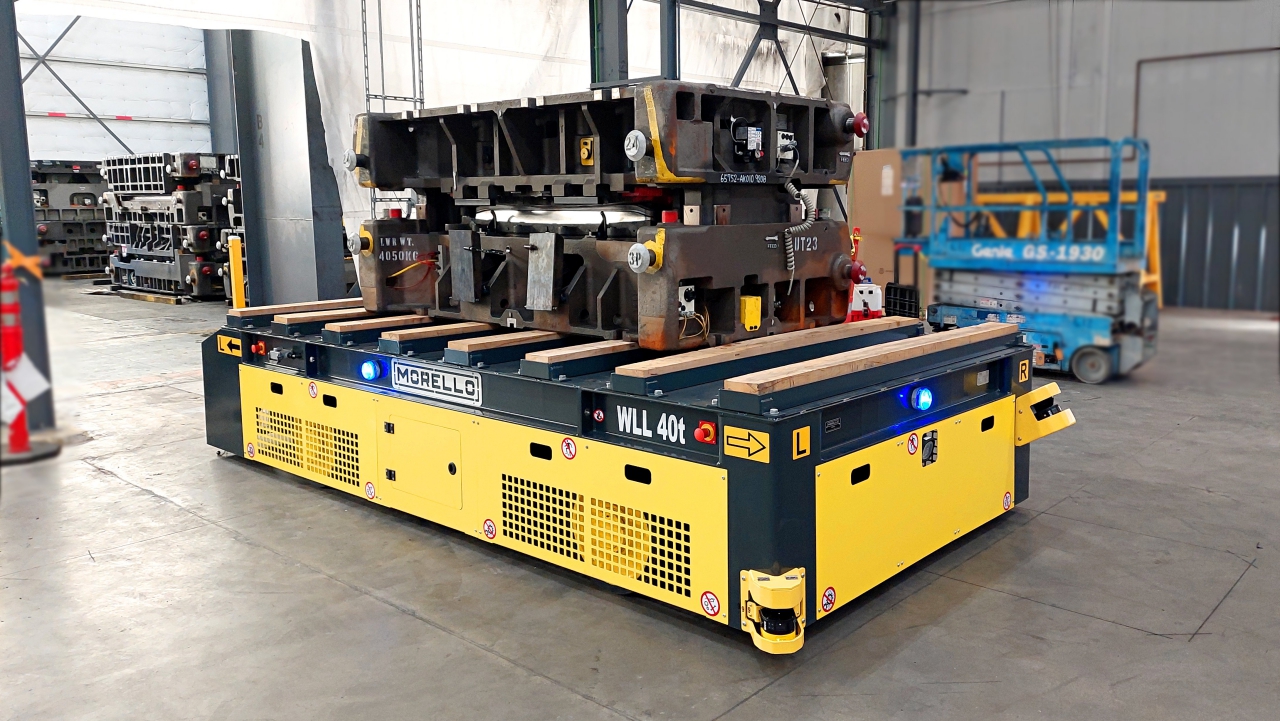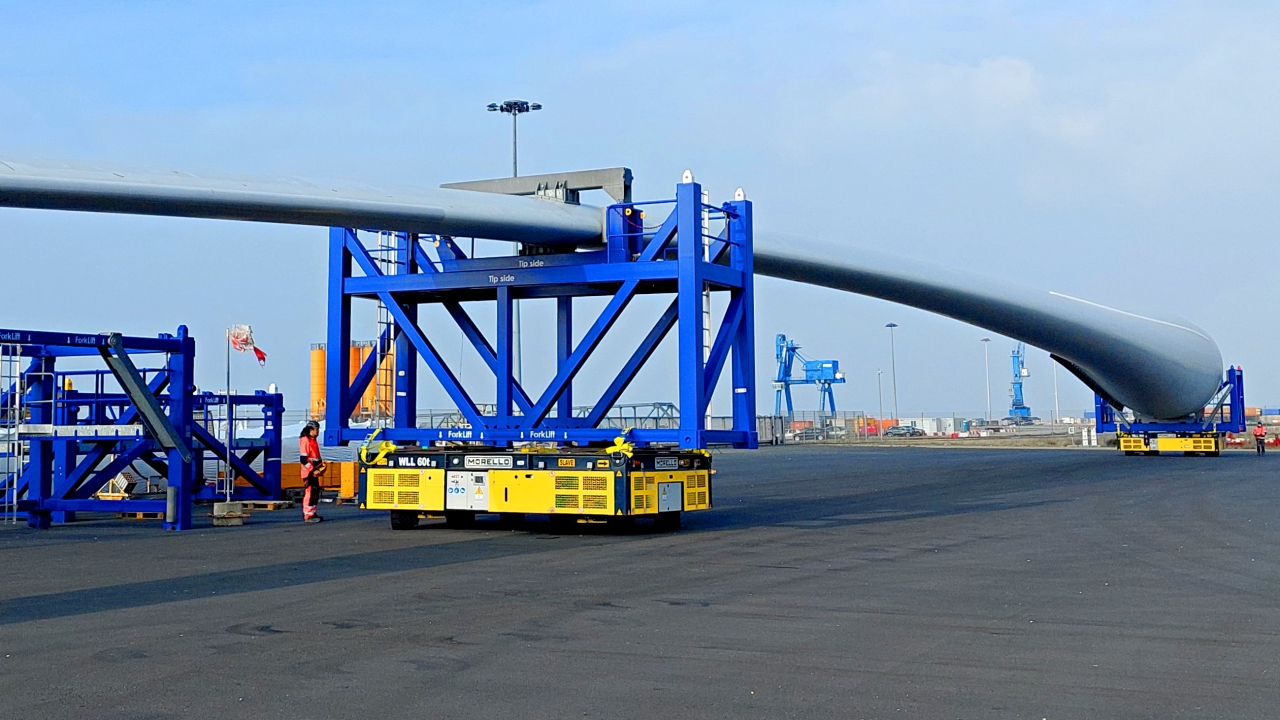When it comes to handling heavy loads internally—whether steel slabs, power transformers, prefabricated modules, turbines, or molds—selecting the right transporter is a critical decision.
With decades of experience designing and manufacturing battery-powered electric carts, self-propelled transfer systems, rail carts, and omnidirectional platforms for heavy loads, Morello brings specialized expertise to help you choose the ideal industrial transporter.
To guide you through every step of the evaluation and selection process, we’ve prepared a practical guide to clearly define your requirements and identify the best supplier for your needs.
1) Define your load and application requirements
The first step is to conduct a thorough analysis of the load characteristics and the operating environment:
- Load weight and dimensions – Are you transporting steel products exceeding 500 tons, long wind turbine blades, heavy molds, modular equipment, or delicate components? Clearly specifying the load type is essential.
- Operating environment – Will the transporter be used in a steel mill, on asphalt floors, or in corrosive or ATEX zones? Evaluating the flooring type and surrounding environmental conditions is critical.
- Indoor vs. outdoor use – Will the transporter operate exclusively indoors, or will it need to function outdoors year-round in varying weather conditions?
- Mobile vs. fixed paths – Will the transporter follow flexible, changing routes influenced by external variables, or a fixed path where a rail-based system might be appropriate?
- Distances, spaces, and layout – What distances must the transporter cover? How many shifts per day will it operate? What turning radii and maneuvering space are available? These details are crucial for the design team to recommend the most effective solution.
2) Choose the power and steering system
Power source
- Battery-powered transporters: These are quiet, flexible, and emission-free—ideal for indoor environments. Morello offers models powered by either industrial lead-acid or lithium-ion batteries, selected based on operational needs.
- Lead-acid batteries are reliable and cost-effective, suitable for standard duty cycles with planned charging intervals.
- Lithium-ion batteries provide faster charging, longer service life, and support for opportunity charging—making them ideal for high-efficiency operations or multi-shift use where minimizing downtime is essential.
- Diesel-hydraulic engines: Once widely used in heavy-duty industrial transport, diesel-hydraulic systems are now less in demand due to environmental regulations and sustainability goals. While they offer high torque and autonomy—especially useful in outdoor or remote-site applications—their noise, emissions, and higher maintenance requirements often make them unsuitable for modern production settings. Many companies are transitioning to battery-powered alternatives that offer comparable performance with significantly lower environmental impact and operational costs.
Steering configuration
Selecting the right steering system is key to optimizing maneuverability, spatial efficiency, and load stability. Morello provides a range of steering solutions adapted to various industrial needs:
- Front axle steering
- A single steerable front axle, similar to traditional vehicles. Best suited for open spaces and predictable route patterns.
- Double-axle steering
- Both front and rear axles are steerable. Allow for tighter turning radii and improved handling of long or heavy loads.
- Omnidirectional steering (OMNI)
- Motorized wheels capable of 360° rotation. Enables movement in any direction-forward, sideways, diagonally, or spinning in place— ideal for confined spaces or dynamic environments.
- Rail-guided (non-steering)
- Wheels follow fixed steel tracks, eliminating the need for steering. Ensures maximum load stability and accuracy for repetitive, linear movements.
3) Assess payload characteristics and customization needs
How effectively can the heavy load transporter interface with your specific materials?
Customizing the payload deck is critical to ensure safe and stable transport—particularly for loads with irregular shapes, shifting centers of gravity, or high surface sensitivity.
Common payload support configurations include:
- Lifting decks – Integrated hydraulic or electric lift systems that allow for self- loading and unloading without external equipment.
- Saddles for coils – V-shaped or contoured cradles designed to securely hold cylindrical steel coils or cable reels, preventing rolling or shifting during transport.
- Modular load frames – Adjustable brackets or bolted structures that can be reconfigured to accommodate varying load sizes and geometries.
- Turntables – Enable the load to be rotated 90°/180°/360° while on the transporter, reducing the need for additional handling equipment.
- Tipping platforms – Facilitate controlled unloading of bins or containers through vertical or angled discharge.
- Lashing and slinging points – Integrated D-rings or sockets for securing loads using straps, chains, or lifting equipment.
Each of these components can be engineered to match your specific payload—whether transporting hot steel slabs, precast concrete units, aerospace fixtures, or modular equipment skids. Morello’s engineering team works in close collaboration with clients to co-design and customize load-handling features that meet even the most complex operational requirements.
4) Evaluate safety, compliance and environment
Ensure your transporter meets all necessary safety standards and is suited to your plant’s environment:
- Certifications: Verify CE, UL, CSA, or ATEX/IECEx approvals for operations in hazardous zones.
- Safety features: Look for warning systems, anti-collision technology, and ergonomic control to enhance operator safety.
- Environmental sustainability: For outdoor or corrosive settings, select steel construction or specialized corrosion-resistant coatings.
5) Consider flexibility and integration needs
Evaluate not only the current application but also the transporter’s adaptability to future layout changes or plant expansions.
- Automated Guided Vehicles (AGVs): provide hands-free operation along repeatable routes.
- Manual and hybrid fleets: offer versatility to handle diverse transport scenarios.
- Fleet management: Ensure seamless integration of multiple units for coordinated workflows and centralized scheduling.
6) Prioritize maintenance, support and training
A lower total cost of ownership begins with strong support:
- Training and documentation – Morello comprehensive assembly, maintenance guides, and operator manuals compliant with EU regulations.
- Local service network – reliable access to parts, service, and training is critical.
- Remote diagnostics – telemetry for battery health monitoring, fault detection, and preventive maintenance enhances uptime.
7) Conduct a site visit and pilot test
Evaluating the transporter in a real-world context is essential:
- Planning – Collaborate with technical experts to conduct a site walkthrough, assess floor conditions, map routes, and identify loading/unloading zones.
- Pilot/demo test – Operate a unit under actual working conditions to assess:
- Turning radius
- Stability
- Noise and vibration levels
- Battery endurance
- Data review – Analyze key performance indicators (KPIs), including payload volume, runtime, energy consumption, and system downtime.
8) Perform a cost–benefit analysis
Go beyond the initial purchase price to assess total value:
- Efficiency gains: time savings from electric operation and automation.
- Labor optimization: reduces manual handling, freeing personnel for higher-value tasks.
- Operational savings: lower emissions, elimination of fuel costs, and reduced insurance premiums due to improved safety.
- Resale value: high-quality transporters retain significant residual value when properly maintained.
Use these insights to develop a strong business case—many clients achieve full return on investment (ROI) in under 24 months.
9) Summary table
| Step | Key considerations |
| 1 | Load type, environment, and route characteristics |
| 2 | Power source and steering system options |
| 3 | Safety features, certifications, and environmental resilience |
| 4 | Payload capacity and customization requirements |
| 5 | Fleet flexibility and integration with plant systems |
| 6 | Maintenance, training, and technical support |
| 7 | Onsite testing and real-world performance assessment |
| 8 | Total cost of ownership and ROI |
Why choose Morello?
Morello is a recognized leader in the design of custom in-plant heavy load transporters—from battery-powered SGAI, OMNI, and AGV trolleys to rail-guided platforms. With an engineering-driven approach, every solution is precisely tailored to your workflow, certified for your application, and built for long-term reliability.
Next steps
- Explore our step-by-step guide: compare steering configurations, power options, and key technical features.
- Request a technical consultation: our experts will assess your plant’s specifications and recommend the ideal solution.
- Schedule a site demonstration: witness Morello’s transporters in real-world operation.
Choose without complications: the right Morello transporter for your operational needs
Choosing the right industrial transporter doesn’t have to be overwhelming, with Morello, expert guidance is part of the process.
This guide is designed to help you navigate the key considerations when selecting a heavy load transporter, empowering you to make an informed investment aligned with your company’s operational goals. The outcome? Safer, more efficient internal logistics with the flexibility to scale as your business grows.


